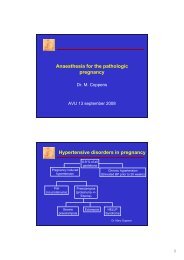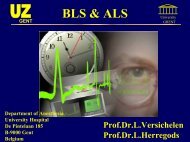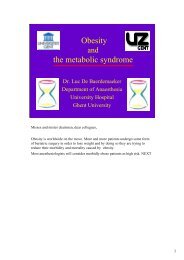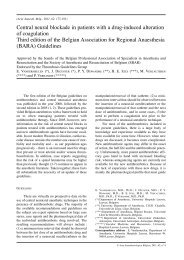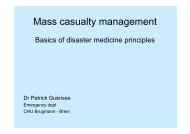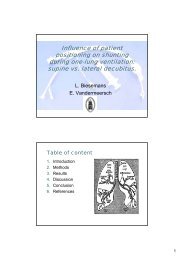Combined spinal epidural analgesia for labor and delivery
Combined spinal epidural analgesia for labor and delivery
Combined spinal epidural analgesia for labor and delivery
Create successful ePaper yourself
Turn your PDF publications into a flip-book with our unique Google optimized e-Paper software.
COMBINED SPINAL EPIDURAL ANALGESIA FOR LABOR AND DELIVERY 113<br />
body in up to 5% of parturients (24). It has been<br />
clearly demonstrated, using radiography <strong>and</strong> ultrasound,<br />
that most anesthetists, using anatomical<br />
l<strong>and</strong>marks, are 1 to 4 interspaces away from where<br />
they think to be (24, 170). Identification of the correct<br />
interspace is there<strong>for</strong>e of prime importance.<br />
Ultrasound may be useful in that respect, especially<br />
in obese patients (24).<br />
Post dural puncture headache (PDPH)<br />
Since CSE involves a dural puncture, there is a<br />
theoretical risk of postdural puncture headache<br />
(PDPH). This is a devastating complication in an<br />
otherwise healthy mother, keen on taking care <strong>for</strong><br />
her newborn child. However, the use of small-gauge<br />
atraumatic <strong>spinal</strong> needles (26-29 G) has dramatically<br />
decreased the problem. From the available literature,<br />
it seems that PDPH occurs in no more than 1%<br />
of patients. Furthermore, the incidence is not<br />
increased as compared to conventional <strong>epidural</strong><br />
<strong>analgesia</strong> (13, 36, 38, 47, 84, 91, 98, 100, 109, 110,<br />
160, 161, 167). NORRIS et al. reported that unintended<br />
dural puncture with the <strong>epidural</strong> needle occurs<br />
much more frequently when using conventional<br />
<strong>epidural</strong> <strong>analgesia</strong> as compared to CSE (110)<br />
Rarely, the <strong>spinal</strong> needle itself is responsible <strong>for</strong><br />
PDPH. Usually, a dural tap with either the Tuohy<br />
needle or the <strong>epidural</strong> catheter causes postural<br />
headache. It is also worthwhile to mention several<br />
reports advising to insert the <strong>epidural</strong> catheter in the<br />
subarachnoid space following an accidental dural<br />
tap. The incidence of PDPH <strong>and</strong> bloodpatching<br />
seems to be reduced when the <strong>epidural</strong> catheter is<br />
threaded intrathecally (30, 111, 143, 148, 160).<br />
Of interest is that air should be replaced by<br />
saline in the loss of resistance technique, as air<br />
might cause more PDPH, increase its severity <strong>and</strong><br />
induce other problems with the <strong>epidural</strong> block, such<br />
as recurrent breakthrough pain (3, 88).<br />
Motor block<br />
For many years, strategies to reduce the incidence<br />
<strong>and</strong> severity of motor block, associated with<br />
<strong>epidural</strong> <strong>analgesia</strong>, have been designed. Lower concentrations<br />
of local anesthetic solutions, the addition<br />
of opioids <strong>and</strong> other adjuvant drugs, the introduction<br />
of patient controlled <strong>epidural</strong> <strong>analgesia</strong> <strong>and</strong><br />
the use of newer local anesthetic agents have been<br />
instrumental in reducing problematic motor block.<br />
Low dose <strong>epidural</strong>s are successfully used to allow<br />
<strong>labor</strong>ing women to maintain mobility whilst being<br />
completely pain free (37, 100). With CSE, it is easier<br />
to provide effective <strong>analgesia</strong> with no or very<br />
minute doses of local anesthetics. As already<br />
described, CSE decreases the total local anesthetic<br />
consumption (36, 37, 162) <strong>and</strong> decreases the occurrence<br />
of motor block when compared to a st<strong>and</strong>ard<br />
<strong>epidural</strong> technique (36, 37, 100, 162).<br />
Some authors have questioned about the safety<br />
of walking during <strong>labor</strong> <strong>and</strong> neuraxial <strong>analgesia</strong>.<br />
However, several authors demonstrated that, with<br />
CSE, motor function <strong>and</strong> balance remains intact,<br />
whilst low dose <strong>epidural</strong>s induce clinically<br />
detectable dorsal column deficits (17, 44, 127).<br />
Ambulation became common practice <strong>and</strong> can be<br />
advised, provided that adequate precautions, written<br />
protocols <strong>and</strong> testing of motor function following<br />
initiation of <strong>analgesia</strong> are undertaken. Motor<br />
function testing is straight<strong>for</strong>ward <strong>and</strong> includes the<br />
ability to per<strong>for</strong>m a deep unassisted knee bend <strong>and</strong><br />
to per<strong>for</strong>m a straight leg lift <strong>for</strong> 30 seconds with the<br />
eyes closed. It remains unclear how <strong>epidural</strong> maintenance<br />
of <strong>analgesia</strong> affects postural stability <strong>and</strong><br />
motor function (44).<br />
Caution is required when using <strong>epidural</strong> test<br />
doses following insertion of an <strong>epidural</strong> catheter,<br />
since test doses can significantly impair motor<br />
strength (31). Controversy also exists on the effects<br />
of <strong>spinal</strong>ly administered epinephrine (64, 166) on<br />
the motor block. Whilst minute doses do not impair<br />
motor function, larger doses have a significant<br />
impact. A small dose of intrathecal epinephrine<br />
conveys clinical benefits in terms of prolonged<br />
<strong>spinal</strong> <strong>analgesia</strong> (64, 166).<br />
Although reduced motor block <strong>and</strong> ambulation<br />
during neuraxial <strong>analgesia</strong> are certainly feasible,<br />
controversy concerning the benefits of ambulation<br />
remains (17, 51). Several trials demonstrated that<br />
ambulation during <strong>labor</strong> does not affect the outcome<br />
of <strong>labor</strong> (100), whilst others did note a beneficial<br />
effect. In patients without <strong>epidural</strong> <strong>analgesia</strong>,<br />
ambulation halved the operative <strong>delivery</strong> rate (4).<br />
Ambulation also reduced the length of the second<br />
stage of <strong>labor</strong> (60). In the COMET trial, mobile<br />
techniques of <strong>labor</strong> <strong>analgesia</strong> were associated with<br />
an improved <strong>labor</strong> outcome (37, 38). Despite this<br />
controversy, those women actually using ambulation<br />
during <strong>labor</strong> prefer ambulation, as it increases<br />
their feelings of self control. It was also noted that<br />
<strong>epidural</strong> top-ups administered during ambulation<br />
induced less hypotension than top-ups administered<br />
in the supine position (8).<br />
Progress <strong>and</strong> outcome of <strong>labor</strong><br />
Epidural <strong>analgesia</strong> has been implicated in<br />
prolonged <strong>labor</strong>s, in increased instrumental <strong>delivery</strong><br />
© Acta Anæsthesiologica Belgica, 2009, 60, n° 2



